Biology of carbonate Slopes
Slopes of
carbonate accumulate the remains of biological organisms that either come from the water column above them live on their
surfaces. Commonly the biological organisms that rain through the water column are calcareous nanoplankton (coccoliths) and microplankton (foraminifers). Interestingly, calcareous plankton have only existed since the late Mesozoic so there are no pelagic
carbonate deposits from before this time.
Bottom-dwelling organisms that burrow into
carbonate slope sediments. Different organisms living in different areas across the slope respond to the processes at work in the depositional setting and so exihbit a variety of characteristics
- current strength affects the types of biology by in turn affecting the way they gather food, respire, and secrete calcium carbonate. This in turn affects their morphology.
- depth to which light penetrates
- amount and type of material passing by/settling out on the slope
- amount of oxygen (oxygenated slopes are heavily bioturbated which destroys the primary sedimentary structures there)
Types of Calcareous Biota that constitute the Slope:Commonly, on the lower slope is composed of bioclastic detritus derived from the upper slope deposits. On the upper slope, communities of whole fossil organisms can be seen, as well as some bioclastic detritus. Some of the calcareous marine algae that can be seen on the slope (and shelf) include:
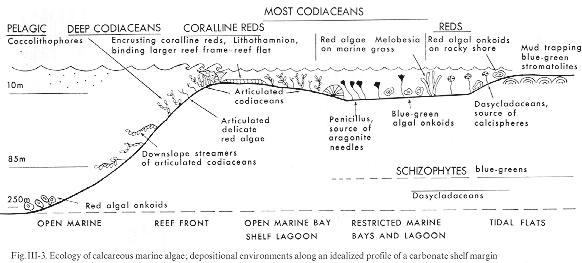
Codiaceans: These calcarerous green algae are common contributors to the
carbonate seidmentary section, Modern Halimeda are examples of these algae (see pictures of Halimeda below).
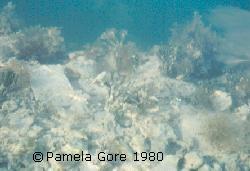
A colony of Halimeda, as seen underwater
(http://www.dc.peachnet.edu/~pgore/geology/geo102/carbs.htm)
(http://www.dc.peachnet.edu/~pgore/geology/geo102/carbs.htm)
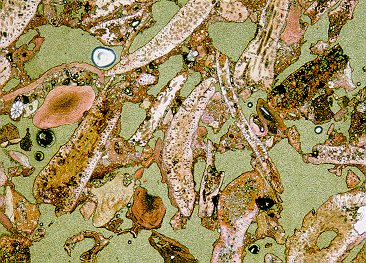
A photomicrograph of codiacean algae, Halimeda in particular.
photomicrograph: http://plaza.snu.ac.kr/~lee2602/atlas2/skel2.html
Oncoids: This type of concentric
carbonate grain is often larger than 2 mm and composed of irregular concentric bands
that vary in thickness and do not have a perfectly spherical form that is characteristic of the commonly smaller more organized ooids.
An oncoid (http://xray.geol.uni-erlangen.de/pal/microfac/oncos_g.htm)Oncoids are common in the carbonate slopes of Permian, Triasic and Jurassic settings.
What is raining through the water column?
Coccolithophores:
Phytoplankton (8-20 micrometers in diameter=nannoplankton) secrete calcareous plates and today, are the second most important primary carbonate producers in the world oceans. They form the chalk deposits at the Maestriction "White Cliffs" of Dover.
Foraminifera:
These zooplankton produce skeletal remains that are composed of calcium carbonate
Peneropolid foraminifera.
Pteropods:
The skeletal remains are composed of aragonite and are organisms that mostly only live in water depths less than 500 m. They are especially common in warmer tropical seas.
Calcareous Ooze:
These oozes can be composed of any of the above planktonic faunas and accumulate on seafloors that are above the carbonate compensation depth (CCD). The plankton must become aggregates in order to fall to the sea floor (this can be accomplished through copepod fecal pellets).
Fossils on the carbonate Slope:Fossils are commonly seen on the bedding planes of the carbonate strata as either body fossils or trace fossils.Body fossils of macro-organisms in pelagic carbonate deposits are very rare; however, on the shelf, they are very abundaformnt. Therefore, on the continental slope a gradiation from greatest abundaformnce at the upper slope to lowest abundaformnce at the tow of the slope is observed.It may be that the limited amount of oxygen in the bottom waters limits the extent of these creatures.Trace fossil assemblages are commonly found on the slope include: Chondrites, Helminthoida, Paleodictyon, Planolites, Teichichnus, and Zoophycos.eg:
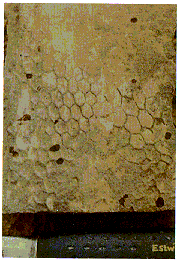 Paleodictyon(Scholle et al., 1983)
Paleodictyon(Scholle et al., 1983)
This affects the porosity, permeabililty, mineralogy, structural strength, and grain size of the limestons. It can be caused by "pressure solution"-- that is the dissolution of a grain by the pressure of one grain on another. Diagenesis results in the transformation of limestone to dolomite (dolomitization), also aragonite is replaced by calcite.Hardgrounds:
These result from the cementation of pelagic sediments by high Mg-calcite (aragonite) and/or glauconite and/or calcium phosphate. Hardgrounds are best formed when the sediment is exposed to the seawater for an extended period of time (i.e., slow sedimentation rate- either from winnowing away of sediments or slow supply rate). Numerous hardgrounds can form in one area as sea level is lowered over time (with the time from the generation of one hardground to the next being thousands of years).They reduce the porosity of the sediments by as much as 90%.They are important because they act as the substrate that organisms can burrow into. Many organisms need a hard substrate because they are unable to burrow into soft, muddy, water laden sediments.The presence/absence of a hard substrate determines to what extent organisms can develop. The sometimes surprising presence of deep hardgrounds results in the presence of bioherms deeper than usually thought. Cementation:
carbonate sediments are almost always cemented by carbonate minerals, as they do not become very compacted after burial (as do siliclastic sediments). Burrows of organisms can provide areas in which coarse sediments can become trapped and cemented. The cementation process first affects coarser (more permeable) sediments. The cementation cycle is one that begins with an initial cementation, after which organisms burrow into the substrate (which has hardened as a result of the initial cementation), entrapment of sediment by the organisms and hence more cementation of the surface. Also, as a slope steepens, it becomes more easily cemented (a positive feedback).The cementation of an area may (or may not) continue until a hardground is developed. The amount of cementation decreases downslope because of the decreasing influence of currents.Evidence of cementation can be seen in the concentric onion skin-like coatings of the crust, each about 10 cm thick.Table showing the modern and ancient carbonate sediment components.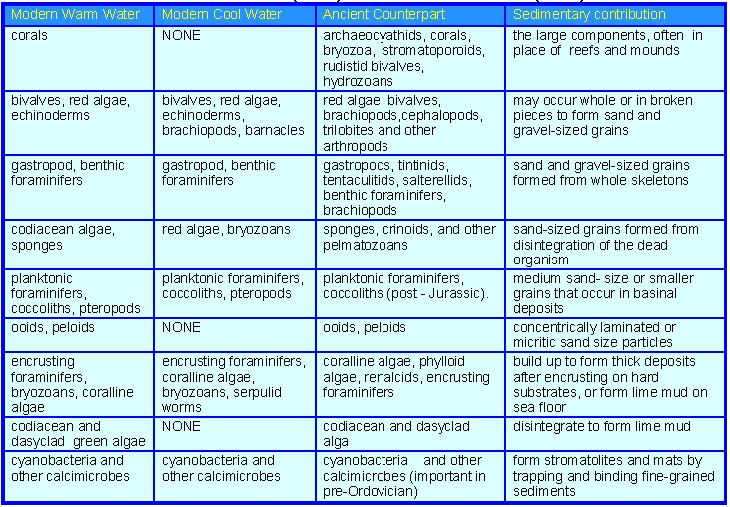
University of Berkeley web image
References and Sources:Coniglio, M., Dix, G.R. carbonate Slopes in Facies Models: Response to Sea Level Change. Ed. R.G. Walker and N. P. James. Geological Association of Canada, St.Johns: 1992. pp 349-373.Scholle, P.A., Bebout, D.G., Moore, C.H., (Eds.). carbonate Depositional Environments. AAPG Memoir 33, Tulsa: 1983.Stanley, S. Exploring the earth and life through time. W.H. Freeman and Company, New York: 1993.Wilson, J.L. carbonate Facies in Geologic History. Springer-Verlag, New York: 1975.